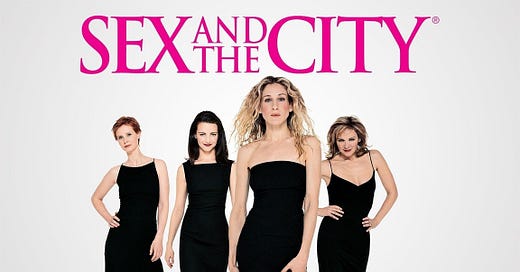It was May of 2008, and Barack Obama’s presidential campaign was in full swing. It was a heady time. Hope was in the air.
I had much less hope for what I was about to see as I sat in a crowded San Francisco theater filled mostly with women, waiting for the movie to begin. But when I heard the Sex and the City theme music, I couldn’t help feeling a little thrill of anticipation. I could feel everyone else in the theater feeling it, too. That music took us back.
What was it taking us back to?
The Problems with Sex and the City
Sex and the City was, by just about any measure, a Very Bad Show. I know, that’s subjective. But here’s my opinion: the writing and acting were mediocre at best, the characters were shallow and two-dimensional, and so much about the show just didn’t make sense.
Carrie Bradshaw’s tutus, skirts with tails, and outfits garnished with gigantic flowers don’t strike me as the height of fashion — but then, what do I know. What I do know is that on her writer’s salary, Carrie definitely could not have afforded her lavish lifestyle. Other shows take similar liberties; the friends in Friends had apartments well beyond their means, as did those zany Seinfeld characters. But Sex and the City took it to a new level.
Much has been written about the extent to which Carrie’s expenses exceeded her income. Candace Bushnell, the writer of the real-life column that led to the TV show, was making $60,000 writing for Vogue in the 1990s — a very good salary at the time. But even if Carrie’s salary matched that, it wouldn’t have been nearly enough to support a closet full of extravagant designer outfits featuring $400 shoes — estimated to have added up to $175,000 in just one season — plus the constant drinking and dining out in New York City’s finest establishments.
But more troubling to me were the characters. For one thing, those four extremely different women would never have been best friends. For another, they were more caricatures than characters.
Charlotte and Samantha were particularly objectionable. Charlotte, a toxic cliché of a traditional, prudish woman, was far too prim, proper, and marriage-obsessed to be hanging out with the rest of the group. Samantha, on the other hand, embodied a stereotype at the other extreme: a woman unabashedly focused on sex who therefore, naturally, showed little warmth and was unable to sustain a long-term relationship. How many times have we seen that cliché?
To be fair, Carrie and Miranda were less extreme. But like the other two, they were self-centered, entitled, and materialistic. I wouldn’t have wanted to hang out with any of those women.
What made it all worthwhile
By now you may be wondering why the Sex and the City theme music set my heart a-flutter years after the show had ended. And why did I hang out with those women many a night in my living room? What was so good about a show that was so bad?
To understand that, we have to go back in time to the 1990s.
When Sex and the City debuted in 1998, 25 years ago this month, it was revolutionary. I don’t say this lightly.
Today, it might not seem like a big deal for women TV characters to talk about sex openly, extensively, and in detail. In the 1990s, it was unheard of. I recall an episode in which Carrie tells “the girls,” during one of their many outings, that the previous night she’d had the most intense orgasm of her life. What?? In the 1990s, no one talked about the quality of their orgasms on TV.
They might mention sex in a general way. Friends went farther than most, with Monica gushing that she’s had the best sex of her life with Chandler and Rachel giving Ross credit for how good he is with his hands. But there was still an air of evasion and coyness about these passing mentions.
Even Seinfeld, which aired an entire episode about masturbation in 1992, made that episode noteworthy by never once uttering the word. To give that Very Good Show due credit, the episode has Elaine fail a contest to see which of the friends can hold out the longest without masturbating — debunking a myth about women without making a big deal of it. In another episode, Elaine assesses whether various potential male sexual partners are “sponge-worthy.” Indeed, in dealing with salacious topics without crossing the line of what was considered acceptable at the time to say out loud, Seinfeld was a master of its domain.
But Sex and the City didn’t hold back. And not just when it came to orgasms. Oral sex, rimming, the taste of semen — it was all fair game, and it was all discussed in a straightforward way. In one episode, prim Charlotte becomes addicted to a vibrator, which interferes with her life to such an extent that the girls have to stage an intervention. In another, Samantha announces her plans to masturbate all day.
Anyone who’s grown up in the current era of TV might be accustomed to the frank discussions and depictions of all kinds of sex in Girls, realistic treatment of women’s sexuality in Orange Is the New Black, and acknowledgment of the sexuality of young women in Sex Education, with its wonderful “It’s my vagina” scene. For that audience it’s hard to convey how striking — and refreshing — all of this was in the 1990s. To see women characters talking about sex in a normal way, like the normal part of life that it is — that alone made Sex and the City worth watching.
And that made it a truly important show.
More than just paving the way for the current era of TV, Sex and the City made a mark on our collective understanding of women’s sexuality. This understanding has a fraught history, with women being ascribed whatever attitude toward sexuality is considered negative at the time. In the Middle Ages we were sex-crazed seducers; now, we apparently have to be convinced to have sex. Women’s sexuality has for too long been poorly understood, considered overly complex and mysterious.
One TV show alone can’t change these persistent attitudes, and I don’t claim that Sex and the City did that. It even perpetuated some of the harmful stereotypes about women in the characters of Charlotte and Samantha. But it was the first popular, mainstream show to depict a fuller, more well-rounded view of women as sexual beings — with the women themselves in charge of their sexuality and the narratives about it.
And let’s face it — despite its flaws, the show was also fun. Even addictive. For me, Sex and the City had an added appeal. In 1998 I was in my thirties, like the girls. Having gotten divorced a year before the show began, I was single, like the girls. I was dating, like the girls — and like the girls, I talked about my experiences, sometimes in detail, with my friends.
While I couldn’t relate to the upscale lifestyle and extreme materialism depicted in the show, I could relate to the many foibles of dating in the city — an experience that was new to me at the time. So many of the stories on Sex and the City echoed experiences that I’d had or that friends had related to me. Watching the show made me feel less alone in those experiences and made it easier to see the humor in them.
At the time, I had fantasies of creating my own downscale San Francisco version of Sex and the City. It was great to see women characters on TV talk about sex, but I wanted to see characters who were more like me. Would people watch a downscale version that lacked the excitement of New York, which added to the glamor, glitter, and sparkle of the show? Maybe it would have worked as a kind of updated Tales of the City. We’ll never know. Someone should have made it, but that moment has passed.
Here we are 25 years later, and the second season of the sequel, And Just Like That, has just premiered. The general view on season 1, which I share, is that it didn’t measure up to the original — and by now you know how I feel about the original. In the reboot, the jaunty theme music is gone but the characters are as annoying and superficial as ever; their materialism seems to have escalated, if anything, to cringeworthy levels. Even worse, there’s no longer anything groundbreaking about it. Instead of breaking ground, in fact, the new show feels like it’s straining to keep up — and often falling flat in the attempt.
But did I watch season 1? And am I now watching season 2? Yes, dear reader, I did. I am. Don’t judge me.







So, to summarize: Weak and compromised characters, ridiculous outfits, unsupportable materialism, narcissistic comedy, and generally few redeeming characteristics... except for openness about sex. Hmm. That could describe either the Roman elites during the Caligula years or the entertainments of our era. Oh well.
YNO PARO DE VER SEX AND THE CITY SRIE Y PELICULAS VEO MUCHOS CLICHES Y CREO QUE ESO ES LO QUE JALA AL PUBLICO.